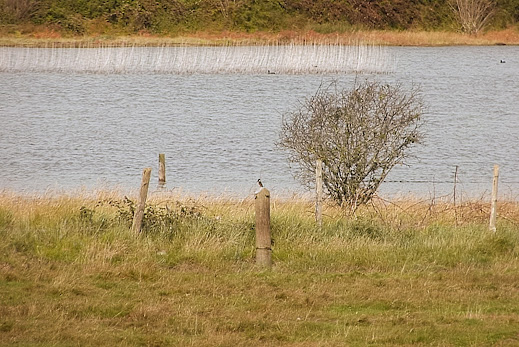Farlington Marshes, Hampshire:
My plan this morning was to meet Geoff Farwell at Farlington Marshes this morning around 11am and also Emma and Matt Parkes, if they could make it. Sure enough, all turned up on time as we met at the lake area of the reserve. I wanted to see for myself the devastation caused by the broken Sluice gates that has let all the seawater onto the reserve and destroying not only most of the reedbeds, but also created a saline lake where there should of been a small area of water surrounded by mud for the waders to roost at high tide. We even met local birder Jason Crook who gave his version of events and his disgust on what such awful marsh management has taken place here and could have so easily been avoided. Even if the Sluice gates are eventually replaced, the damage done to the reedbeds looks as though it is irreplaceable and most likely never to grow here again?
On a positive note, we had a good four hours here and were rewarded with a good variety of birds here on the reserve. Starting with the Lake itself; a large contingent of Coots had now replaced the waders; although on the north side of the Lake, there were a small flock of Redshank, a couple of Greenshank with them and closer by, a pair of Black-tailed Godwit. A pair of Great Crested Grebes swam among the Coot and close to the waters edge near the viewing platform, there were at least two Little Grebes fishing among the dead reeds. Matt and Emma turned up and while waiting for Geoff to arrive, we had sightings of a female Marsh Harrier, a female Kestrel, a male Peregrine and out in the fields with the Cattle, up to three Cattle Egrets could be seen through the telescope. A pair of Ravens then grabbed our attention as they flew high over the reserve and then headed off north.
Geoff eventually joined us and after a brief chat, we made our way around the perimeter wall. We stopped to check out what the small passerine was on the wire fence, which transpired to be a male Stonechat. A female Stonechat then popped up and a Wheatear was seen further along the fence. A Whinchat was also found on the same stretch of fencing and now all three Chat species were on the fence together! Jason Crook then joined us for a chat and his version of events about the poor management on the reserve and while he continued to talk to Geoff, we all picked up a Kingfisher perched on a fence-post by the main Lake. The bird kindly entertained us for the next 15 minutes or so, flying up and down the area and was even seen catching a small fish and battering it against the fencepost! I even let a few interested people look through my scope to check out the Kingfisher.
Out in the harbour, the tide was going down rapidly and I found a group of 11 Harbour Seals resting on the mudflats south of the small islands and promptly put the guys onto the Seals. A Common Sandpiper soon entered the scene when it was first heard and then seen flying towards us and then back towards the Lake again. By the Point Field, a further three more Whinchats were seen along with several Meadow Pipits and the briefest of sightings of a Dartford Warbler flying into the brambles, but no further sign. A Yellow Wagtail flew overhead and landed in the Point Field and although I could hear it, the bird was not visible up until it eventually flew off towards the distant Cattle.
The Deeps area was also an area of controversy with large hill-like mounds now in place. For what purpose, who knows? But they certainly looked unsightly as did the ploughed up field to the north of the Deeps. What the hell is going on here? The Deeps was literally void of any birds apart from a flock of Linnets and no waders whatsoever! There was no sign of any Ospreys or raptors on the islands out in the harbour, but another Wheatear was found in the field near the Blockhouse, as was a female Kestrel in the fields. We had good views of a Small Copper butterfly on the brambles; a species I have only seen a handful this year. Also, Common Blue’s, Small Heath, Small White and Meadow Brown’s were seen along the perimeter wall and a lone Red Admiral was seen further along the footpath. Both Common Darter and Migrant Hawker dragonflies were abundant on the reserve today and later in the day, Geoff told me that the Willow Pool, over in the south side of the Marshes, was holding Small Red-eyed Damselflies. Interesting.
We met up with three ‘Lazee’s’ on the seawall: Pete Gammage, Northern John and Andy Friend and while having a good chat about our respective sightings today, a Sparrowhawk was seen distantly soaring to the north of the reserve; our fifth raptor of the day.






















No comments:
Post a Comment